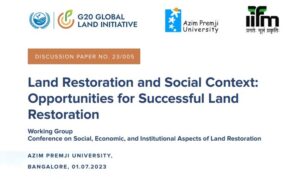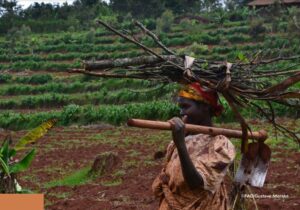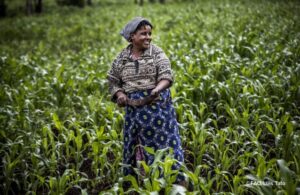 This Discussion Paper was originally published here. It is republished on this website with permissions
This Discussion Paper was originally published here. It is republished on this website with permissions
-
Background
Land restoration is an intentional activity that initiates or accelerates the recovery of an ecosystem with respect to its health, integrity, and sustainability.[i] There are numerous studies documenting substantial economic, social, and environmental benefits from land restoration.[ii] [iii] [iv] However, despite this, the rate of land degradation remains significantly higher than the rate of land restoration globally.[v] Some of the reasons behind this continued land degradation are well known, such as social and longer-term nature of most land restoration benefits, numerous economic and institutional barriers for land restoration, such as land tenure insecurity, lack of access to funding, lack of extension and rural advisory services, and others. However, there are also numerous examples of communities and countries which achieved significant land restoration successes. This conference provided a valuable opportunity to discuss and exchange about successes and failures of land restoration focusing on the social context, and highlighted solutions and opportunities for successful land restoration.

-
Entry points for successful land restoration
2.1 Applying systems-based perspective for land restoration
Considering only one factor in land restoration policies is not adequate, the same factor may work differently in different social contexts due to the presence or absence of complementary or supplementary factors. Need to adopt a systems-based approach with context-specific, ecosystem-specific lens to make this connection transparent. A system’s view may help identify the weaker links or nodes in the land and ecosystem restoration programs and help policy steps to strengthen them. Along with economic, institutional, legal, and policy factors, cultural factors need also be given role and consideration while designing land restoration projects. In most countries, there are multiple, interacting policies in place that affect the status and trend of ecosystems. Some of these policies encourage further destruction while others lead to restoration. Among these policies that have either a destructive or a restoration effect there are considerable interactions and contradictions that need to be accounted for balancing potential losses and gains. For systems-level analysis scale matters. It would be important to refer to the landscape scale, which allows us to consider the multiple dimensions and factors that drive degradation but also enable land restoration.
2.2 Targeting and prioritizing restoration needs
The funding need for land restoration is likely to be well over several trillion US dollars globally. Currently, there is a significant lack of financial resources being channeled to land restoration. Resource scarcity requires appropriate targeting and prioritization of restoration needs. Targeting means not only prioritization of restoration sites, but also appropriate matching of least costly restoration technologies to achieve the same level of restoration outcomes. It is also important to identify the timing sequence of these restoration activities and coordinate restoration across various scales, because of landscape level dependencies and interrelationships between areas to be restored. For example, land restoration action plans under the Rio Conventions have national commitments of how much area to restore, but the specific locations of these restoration sites are usually not identified, making it difficult to rigorously monitor the progress in land restoration. Having spatially explicit restoration commitments will enable us to prioritize restoration activities and track their progress much more effectively and efficiently.
2.3 Monitoring and learning from longer-term land restoration impacts
From a policy perspective, it is essential to require monitoring and impact evaluations as part of restoration and include associated monitoring and evaluation costs in the price of restoration projects. In many cases, this is not done due to lack of funding. Without long-term monitoring and impact assessments, however, it is not possible to robustly tell which approaches worked and which ones failed to restore ecosystems. Monitoring and impact assessments, thus, allow for numbered measures of success and failures of land restoration, providing essential learning opportunities for improving land restoration activities.
2.4 Accounting for social distributional effects
Ecosystem restoration presents net benefits for the entire society, but it also will create winners and losers. This is when restoration efforts create global benefits, but also generate local losses of livelihoods especially for more vulnerable groups of populations. For example, if rangeland restoration is conducted through establishing enclosures preventing local populations from continued use of these rangelands, then this represents a net economic loss to those populations. Another example is the implementation of ecosystem restoration projects in areas with acute competition between pastoralists and crop producers where restoration activities may favor one group at the expense of the other. Implementation of land restoration activities in areas with contested land tenure regimes can also create winners and losers, amplifying existing social inequalities and potentially even conflicts because quite often the local elites may be able to “capture” the benefits of ecosystem restoration. This means that land restoration projects need to carefully study and analyze local conditions in the areas where restoration activities are planned to compensate the losers from land restoration and also avoid exacerbating power asymmetries. For increased investments into land restoration there is also a need to increase social demand and ownership for land restoration. Multi-stakeholder approaches can bring all actors together in co-creating shared understanding and vision of what lies ahead. Such approaches allow trade-offs and benefit distribution to be addressed from the outset. In this regard, a rarely discussed issue is the funding for relevant social processes such as multi-stakeholder engagement, trust building, or those leading to co-creation of shared planning; these interventions are essential for long-term multi stakeholder collaboration and trust. Without such buy-in, restoration activities are likely to fail in the long term.
2.5 Making land restoration gender responsive
Increasing awareness is required about women’s roles both in food production, land management, and land tenure. Gender-blind policies, technology design and dissemination reduce the potential impact for adoption – and may even reinforce existing prejudices and inequalities. Gender-related issues in land restoration should always be assessed in context-specific, as well as general ways, and acted upon accordingly. Women need to be given access to the same levels of information, property ownership rights, and access to extension services as men.
2.6 Harnessing sectoral and spatial spillovers from land restoration
Along with these social distribution effects, it is crucial to account and better understand sectoral spillovers, for example on health, on employment, on climate mitigation and adaptation, biodiversity, industrial development, as well as the spatial spillovers, to make sure that land restoration in one location does not lead to economic losses in some other place (for example, by planting a lot of trees upstream and limiting water availability to downstream uses).
2.7 Providing land tenure security
Secure land tenure is an essential ingredient for successful land restoration in many social contexts. Private land tenure is not the only form of land tenure conducive for land restoration. It is possible to own land through inheritances from ancestors (e.g., in customary and indigenous communities). Where this is the case, the customary/indigenous communities usually have traditional restorative knowledge which they contribute through their participation in the restoration activities. Restoration fails because land users exploit the bundles of rights that exist on the land under restoration without fulfilling their responsibilities. The tenure-restoration nexus emphasizes both rights and responsibilities as a precondition for restoration.
2.8 Integrating restoration objectives in land use planning initiatives
Since restoration focuses on improving the state in which the quality and quantity of land (and its associated resources and embedded property rights) support ecosystem functions and services, land use planning (LUP) can play a prominent role in enabling restoration. LUP can serve as a conscious effort to (re-)structure land uses, rules (land tenure) and activities (development) on land to avoid, reduce and reverse degradation. In fact, LUP can serve as a platform for integrating nos. 1-8 (above) into restoration initiatives.
2.9 Strengthening evidence-based research, education, and awareness about land restoration
The topic of land restoration (including indigenous/traditional and scientific knowledge) should be included into different disciplines in tertiary education institutions (e.g., remote sensing, statistics, agriculture) as well as primary and secondary education. Policy makers, practitioners, and users need better training/awareness on restoration practices. More investment in effective advocacy and communication strategies and campaigns is required.
-
Potential contributions from G20 Global Land Initiative
- Advocate for land restoration policies that combine incentives and regulations in response to economic, legal, and cultural contexts.
- Carry out and disseminate the findings of evidence-based transdisciplinary research, education, and training and exchange programs on land restoration.
- Contribute to strengthening local institutions for effective implementation of land restoration.
- Promote coordinated design and implementation of land restoration across the three Rio Conventions and other programs, which will be less costly and more effective.
- Help adopt inclusive land restoration approaches that are gender-responsive and empower indigenous peoples, youth, and other vulnerable groups.
- Contribute to strengthening land tenure security to strengthen ecological integrity and human wellbeing through land use decisions and actions that encourage investments in restorative practices.
- Raise awareness about global and national monitoring and evaluation systems and institutional architecture on land restoration.

-
Working group participants and contributors:
Working group coordinators:
Alisher Mirzabaev, Unique land use/University of Bonn
Nicole Harari, Centre for Development and Environment, University of Bern
Working group participants and contributors:
Agustin Fallas-Santana (Independent researcher)
David Wuepper (University of Bonn)
Enamul Haque (East-West University of Dhaka)
Eugene Chigbu (Namibia University of Science and Technology)
Gary Tabor (Centre for Large Landscapes)
Annika Keeley (Centre for Large Landscapes)
Jianchu Xu (Kunming Institute of Botany and ICRAF)
Nina Bisom (Economics of Land Degradation Initiatove/GIZ)
Ravi Prabhu (ICRAF)
Roy Sidle (University of Central Asia)
Tei Wanata (Hokkaido University)
Victoria Gutierrez (Commonland)
Dr. Chandra Prakash Kala
Dr. Ujjal Kumar Sarma
[i] Society for Ecological Restoration. 2004. The SER International Primer on Ecological Restoration. Society for Ecological Restoration International.
[ii] Ding, H., et al (2017) Roots of Prosperity: The Economics and Finance of Restoring Land, World Resources Institute, Washington DC
[iii] Verdone, M.A., and A. Seidl. 2017. “Time, Space, Place and the Bonn Challenge Global Forest Restoration Target.” Restoration Ecology, 25: 903–911. doi:10.1111/rec.12512
[iv] Nkonya E, Mirzabaev A, von Braun J (Eds). 2016. Economics of land degradation and improvement – A global assessment for sustainable development. Springer. Cham, Germany. https://doi.org/10.1007/978-3-319-19168-3
[v] Quang Bao Le, Alisher Mirzabaev, Ephraim Nkonya. (2016). Biomass Productivity-Based Mapping of Global Land Degradation Hotspots, in “Economics of Land Degradation and Improvement – A Global Assessment for Sustainable Development”. Bonn, Germany: Springer Verlag (Germany)

